|
November 2022 - February 2023
|
| |
|
|
|
 |
|
 |
| |
|
Publisher: Chairman Yuh-Renn Wu Editors: Professor Snow H. Tseng, Ms. Hsiao-wen
Lin March 30, 2023
|
| |
|
 |
|
Congratulations to Prof. Jiun-Haw Lee for the honor of being awarded “2023 Optica Fellow.” (Optica, formerly OSA)
Congratulations to Wei-Ting Ting and Shih-Chieh Su for being awarded “IEDMS 2022 Best Thesis Award.”
| Student |
Award |
Advisor |
|
Wei-Ting Ting
(Master Student)
|
IEDMS 2022 (International Electron Devices & Materials Symposium 2022)
Best Thesis Award
Thesis Title: Design consideration and Optimization of high voltage vertical β-Ga2O3 Schottky barrier diodes with trench staircase field plate
|
Prof. Chao-Hsin Wu
|
|
Shih-Chieh Su
(Master Student)
|
IEDMS 2022 (International Electron Devices & Materials Symposium 2022)
Best Thesis Award
Thesis Title: A record-high mobility of ~ 22 cm2/V-s in a bottom-gate SnS2 field-effect transistor by a pre-pattern process
|
Prof. Lung-Han Peng
|
Congratulations to Bhaskar Jyoti Borah for being awarded “Taiwan Photonics Society Prof. Shun-Lien Chuang Memorial Award 2022.” (formerly TPS Best Student Thesis Award PhD Division)
| Student |
Award |
Advisor |
|
Bhaskar Jyoti Borah
(PhD Student)
|
Taiwan Photonics Society Prof. Shun-Lien Chuang Memorial Award 2022 (formerly TPS Best Student Thesis Award PhD Division)
Thesis Title: Nyquist-exceeding high voxel rate acquisition in mesoscopic multiphoton microscopy for full-field submicron resolution resolvability
|
Prof. Chi-Kuang Sun
|
Congratulations to Yu-Hsin Kuo for being awarded “Taiwan Photonics Society Best Student Thesis Award 2022.”
| Student |
Award |
Advisor |
|
Yu-Hsin Kuo
(Master Student)
|
Taiwan Photonics Society Best Student Thesis Award 2022
Thesis Title: Investigation of HfZrO2 Ferroelectric Thin-Film-Transistor Based on InGaZnO Channel
|
Prof. I-Chun Cheng
|
Congratulations to Yao-Tung Chang (GIPO Advisor: Prof. Jui-Che Tsai) and Kai-Wen Chen (GIPO Advisor: Prof. Ming-Hua Mao) for participating and completing the “Double
Degree
Program
between EMSP
and
NTU 2021” and
being
awarded the
following honors.
| Student |
Award |
Note |
|
Yao-Tung Chang
(Master Student)
|
EMSP (European Master of Science in Photonics)
Highest Distinction Award
|
Summa Cum Laude (Highest Distinction, Latin), awarded to only one person per academic year.
|
|
Yao-Tung Chang
(Master Student)
|
EMSP Best Thesis Award
|
|
|
Kai-Wen Chen
(Master Student)
|
EMSP Best Thesis Award
|
|
|
Yao-Tung Chang
(Master Student)
|
IMEC-AWARD
|
Thesis award given by IMEC (Interuniversitair Micro-Electronica Centrum VZW), Belgium.
|
Congratulations to Prof. Guo-Dung Su and Prof. Yuh-Renn Wu for representing
EECS and participating in the “NTU Interdepartmental Cup Softball Competition Faculty Division 2022,” and the honor achieving the Silver Award.
Congratulations to Prof. Ching-Fuh Lin for being awarded “National Science and Technology Council Distinguished Researcher 2022.”
Congratulations to Prof. Chi-Kuang Sun for the honor of being appointed Chairman of Taiwan Photonics Society.
Congratulations to Prof. Yuh-Renn Wu,
Ms. Li-Chi Yao, and
Ms. Ching Chien for participation in the “NTU Sports Competition 1200 Meter Mixed Relay Faculty Division” and achieving
the Silver Award.
Congratulations to Prof. Yuh-Renn Wu for
representing
EECS
and participating in the “NTU Faculty Badminton Competition” and achieving
the Silver Award.
Congratulations to the following students for being awarded “OPTIC 2022 Student Paper Award.”
| Student |
Award |
Advisor |
|
Chih-Yuan Tsai
(PhD Student)
|
OPTIC 2022 Student Paper Award – Oral
Thesis Title: Experimental Characterization of Highly Efficient Full-Color 1588 PPI Micro-LED Displays
|
Prof. Ching-Fuh Lin
|
|
Ting-Shan Lee
(Master Student)
|
OPTIC 2022 Student Paper Award – Oral
Thesis Title: Influence of Surface Plasmon on Optical Detection of Picosecond Ultrasonic Pulse Generated in Aluminum Nanofilms
|
Prof. Chi-Kuang Sun
|
|
Chi Sun
(Master Student)
|
OPTIC 2022 Student Paper Award – Oral
Thesis Title: Light Collimating with Use of Metalenses for Spatial Incoherence
|
Prof. Guo-Dung Su
|
|
Chien-Hua Peng
(Master Student)
|
OPTIC 2022 Student Paper Award – Oral
Thesis Title: Development of high-speed polarization-sensitive optical coherence tomography imaging based on HCG-VCSEL
|
Prof. Hsiang-Chieh Lee
|
|
Zih-Sian Yang
(Master Student)
|
OPTIC 2022 Student Paper Award – Poster
Thesis Title: Antimonene-Based Sub-terahertz Acoustic Resonator: A Photoacoustic Study
|
Prof. Chi-Kuang Sun
|
|
Chieh-An Chen
(Master Student)
|
OPTIC 2022 Student Paper Award – Poster
Thesis Title: Highly Efficiency Deep-Blue OLEDs based on multiple resonance thermally activated delayed fluorescence (MR-TADF) emitter
|
Prof. Jiun-Haw Lee
|
|
Chang-An Shih
(Master Student)
|
OPTIC 2022 Student Paper Award – Poster
Thesis Title: Development of Optical Coherence Tomography Imaging Engine based on FPGA
|
Prof. Hsiang-Chieh Lee
|
Congratulations to Prof. Chi-Kuang Sun for the honor of being awarded “Research Center for Biotechnology and Medicine Policy 2022 National Innovation Award,” in collaboration with
mesoView.
Congratulations to Prof. Jiun-Haw Lee for the honor of being awarded “2023 SID (Society for Information Display) Fellow.”
|
|
|
|

|
|

|
|
| |
|
|

|
|
November “GIPO Colloquium” Highlights
|
|
Time:
|
2:20 pm, November 11 (Fri.), 2022
|
|
Speaker:
|
Jerry Guo (CEO, Taishin Securities Co. Ltd.)
|
|
Topic:
|
I, will become a Banker! - Experiences in Investment Banking
|
|
|
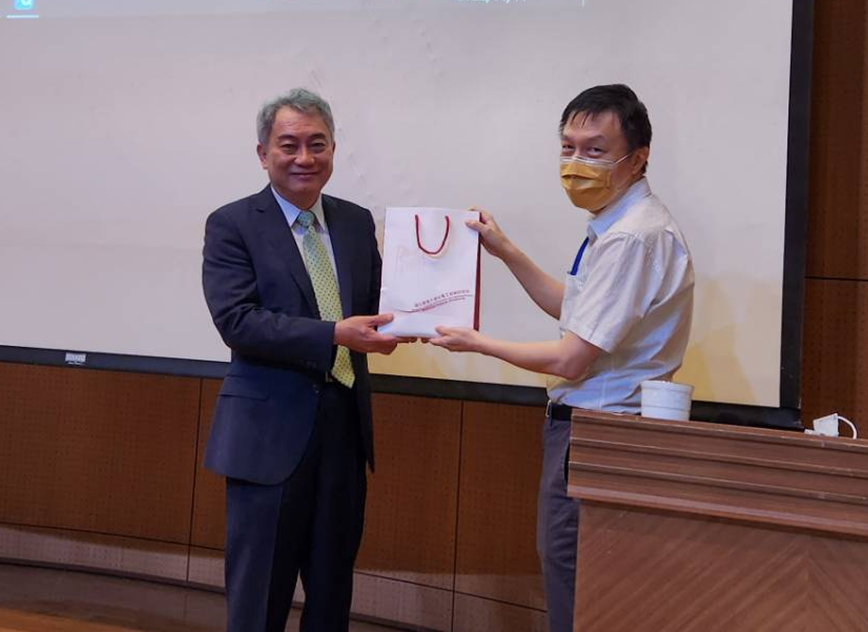
|
|
CEO
Jerry Guo (Left) and Prof. Chien-Chung Lin (Right)
|
|
|
Time:
|
2:20 pm, November 18 (Fri.), 2022
|
|
Speaker:
|
Shih-Chiang Shen (Director, Vanguard International Semiconductor Corp.)
|
|
Topic:
|
200 mm GaN-on-QST Technology
|
|
|
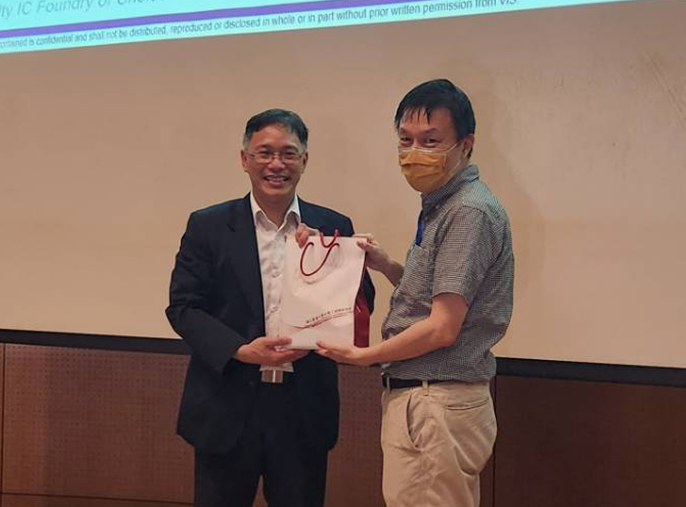
|
|
Director
Shih-Chiang Shen (Left) and Prof. Chien-Chung Lin (Right)
|
|
|
Time:
|
2:20 pm, November 25 (Fri.), 2022
|
|
Speaker:
|
Ching-Lung Ting (CEO, PanelSemi Corp.)
|
|
Topic:
|
Cross-Field Integration and Innovation
|
|
|
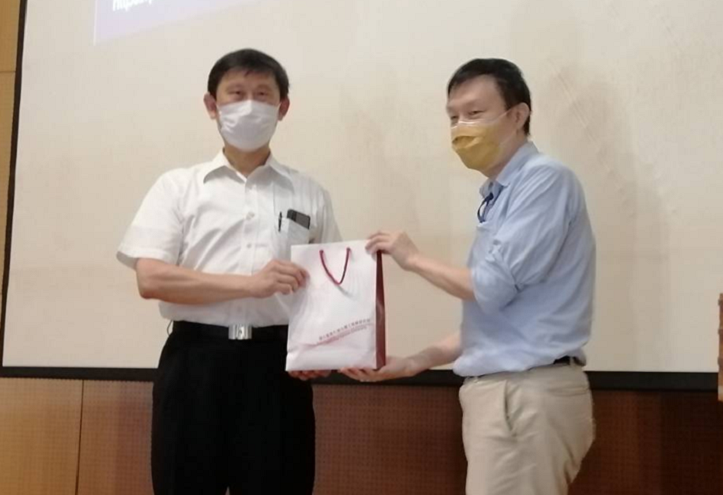
|
|
CEO
Ching-Lung Ting (Left) and Prof. Chien-Chung Lin (Right)
|
|
|
December “GIPO Colloquium” Highlights
|
|
Time:
|
2:20 pm, December 9 (Fri.), 2022
|
|
Speaker:
|
Prof. James C. M. Hwang (Engineering College, Cornell University)
|
|
Topic:
|
Sub-Terahertz Devices and Test Metrology
|
|
|

|
|
Prof. James Hwang (Left) and Prof. Chien-Chung Lin (Right)
|
|
|
Time:
|
2:20 pm, December 16 (Fri.), 2022
|
|
Speaker:
|
Cheng-Han Du (Assistant Manager, Foxconn Technology)
|
|
Topic:
|
Foxconn HPC Solution: Fueling the Future
|
|
|
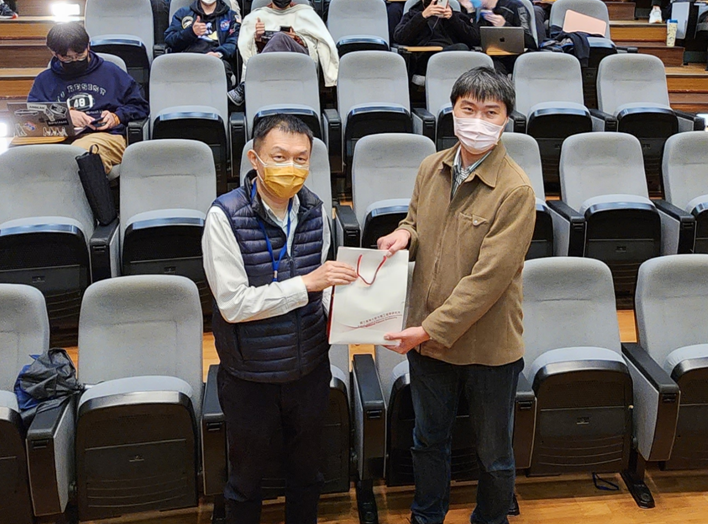
|
|
Dr.
Cheng-Han Du (Right) and Prof. Chien-Chung Lin (Left)
|
|
|
|
|

|
|

|
|
| |
|
|

|
|
~GIPO 30th Anniversary: Inheritance of the Old and Treasure of the Future~
(December 10, 2022, Barry Lam Hall, National Taiwan University)
By Ching Chien
The GIPO 30th Anniversary Celebration was held on a Saturday afternoon on December 10th, 2022, at the Barry Lam Hall, NTU. The event includes a series of seminars, and a dinner inviting all GIPO alumni to join and celebrate.
The seminars were presided by the Chairman of GIPO Prof. Yuh-Renn Wu, and began with a talk given by Prof. Way-Seen Wang and Prof.
C. C. (Chih-Chung) Yang, giving us a brief history on the founding and development of GIPO.
GIPO, the Graduate Institute of Photonics and Optoelectronics, was once the former Division of Optoelectronics of the Graduate Institute of Electrical Engineering. Back at the time of founding, optoelectronics technology was officially listed by the government as one of the key enabling technologies, and in response many universities in Taiwan founded institutes and departments in related fields of optoelectronics, and it was also around this time that the Division of Optoelectronics branched off from the Graduate Institute of Electrical Engineering and formed the Graduate Institute of Photonics and Optoelectronics today. From the day of founding in 1992, GIPO’s contributions encompass a wide range of fields including semiconductor, display technology, photonics, optical communication, and solar energy, with alumni working across many professions exhibiting exceptional competence and leadership.
Then following, Director General Jang-Hwa Leu of Administration for Digital Industries (also a distinguished alumnus of GIPO) gave a brief talk on the current trends of the digital industry scene. Director General Leu observed that with the growth of the economy surrounding and relying on digital technology brings about the increase in both the demands and supplies of digital electronics products, creating many market opportunities. The main goal of Project RISE is to ensure that appropriate digital technology is applied to each field and profession, increasing efficiency and productivity. Director General Leu concluded that the three future directions of digital technology are decentralization, software defined, and vertical application.
Dr. Yun-Li Li, a previous faculty member of GIPO, founder and CEO of PlayNitride, has accomplished remarkable achievements in MicroLED developments. Today, Dr. Li shared with us the many challenges he faced and experienced throughout his career. On the technical side, other than reducing the size of conventional LED into Micro LED, the constant budget concern forces the production line to constantly review its processes to save costs where possible. On the business side, to investors, time is of the essence, the projected production schedule must satisfy investment expectations, so as to ensure that the flow of funds is unhindered. Other than the aforementioned points, how to apply the new technology to the current market is also a great challenge. To entrepreneurs, remaining competitive will always be a constant concern. At this point, Dr. Li expresses that only by continuously investing new talents and building higher and higher foundations for them can this be achieved.
The second half is hosted by the Vice Chairman Prof. I-Chun Cheng and Prof. Jui-Che Tsai, inviting Dr. Cheng-Yen Chen (CEO, Johein Technology), Dr. Chen-Hung Lin (General Manager, Topview Optronics), Dr. Tzu-Huan Cheng (General Manager, LiveStrong Optoelectronics), Dr. I-Chung Chiu (Assist Manager, PlayNitride), Warren Hsiao (Global Commodity Manager, Google), and I-Lin Lu (Hardware Power Engineer, Google). The topic ranges across academic and professional career to life choices. Through the Slido platform, the audience were free to interact with the speakers, who answered questions ranging from annual pay, property purchase, to spouse finding and having children. The speakers all have very different backgrounds. Their diverse life experiences and views each provide insightful inspiration to the current students.
The seminars ended on a good note. The dinner banquet was held at La Maree. For many, it is a chance for professors and students to finally meet again after many years. At the banquet, the main singer of the band is also an alumnus (and TSMC engineer). Photos of their previous lab research days were displayed, and memories re-lived once more. New connections were made, old connections restrengthened, leaving an ambience of new collections of precious memories.
|
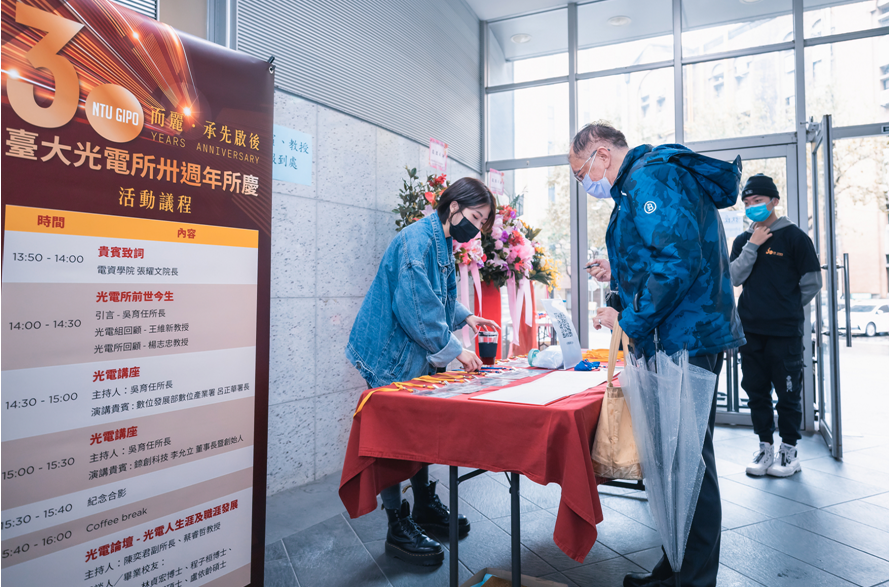 |
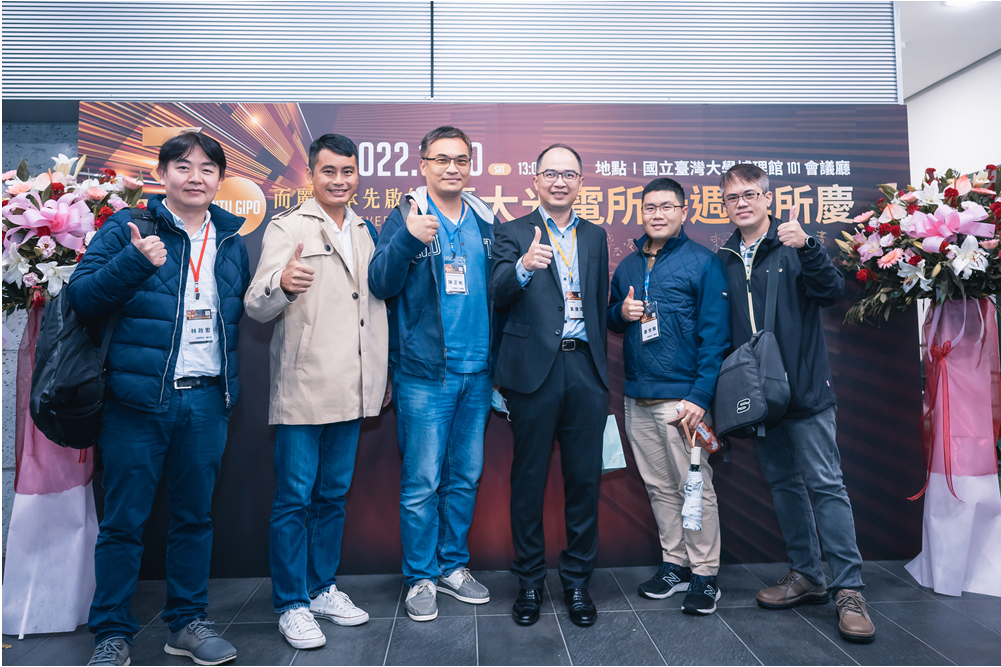 |
|
GIPO 30th Anniversary Seminar and the seminar reception area |
The group photo wall outside the seminar venue |
|
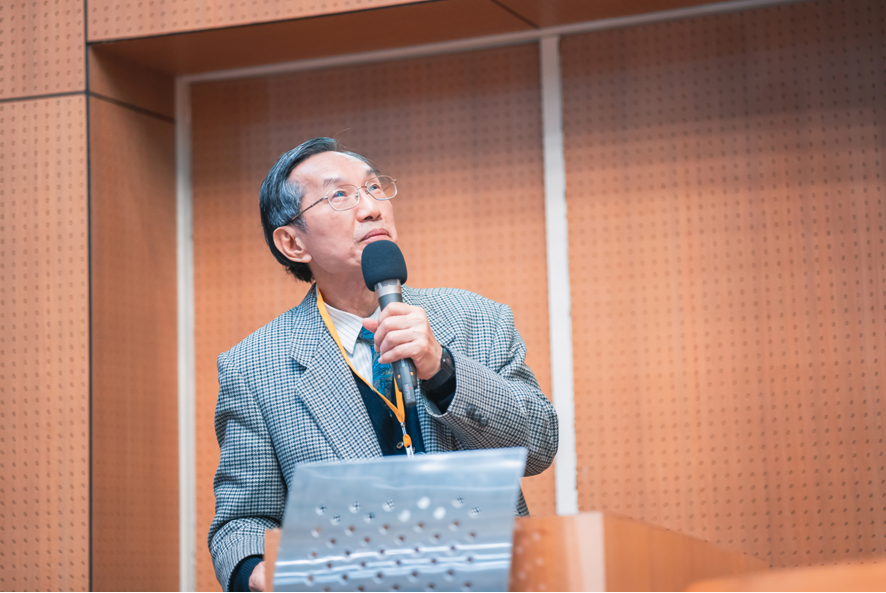 |
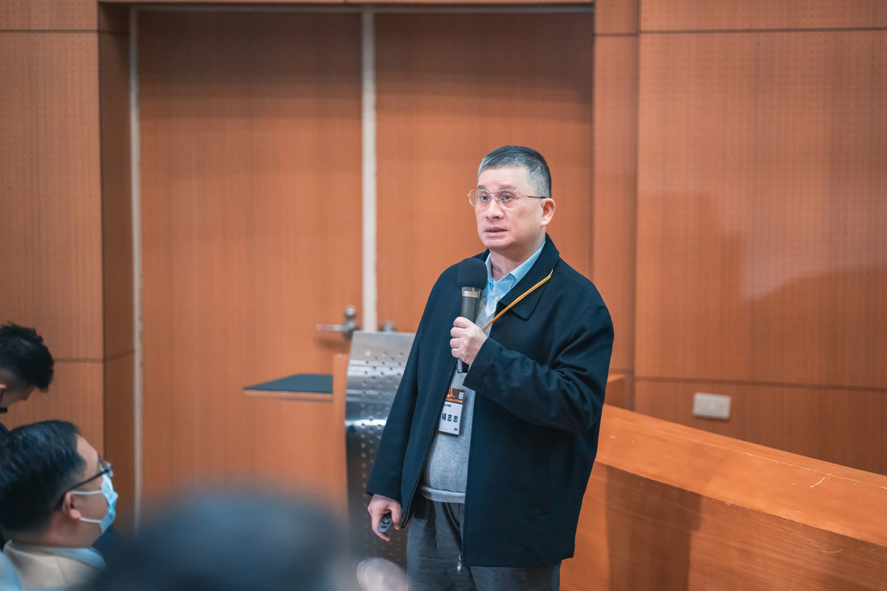 |
|
Prof. Way-Seen Wang on the history of the Division of Optoelectronics |
Prof. C. C. (Chih-Chung) Yang on the development of GIPO |
|
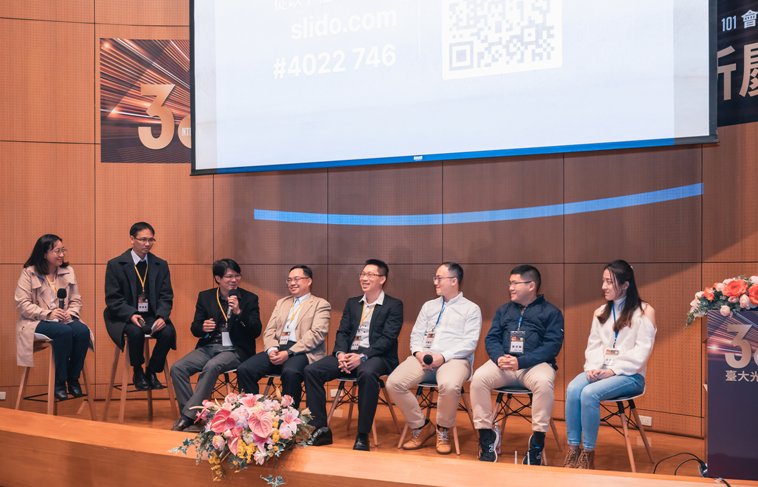 |
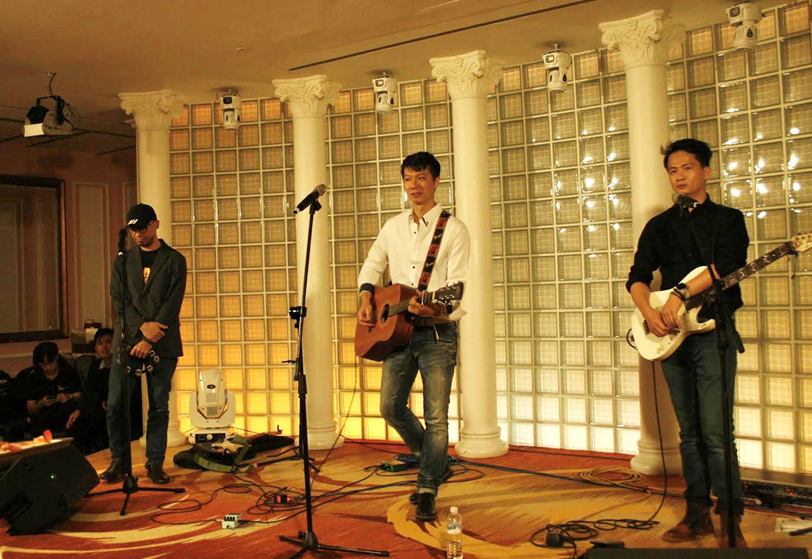 |
|
Lives and careers of GIPO alumni |
The banquet band |
~The 13th International Conference on 3D Systems and Applications~
(November 24-25, 2022, Barry Lam Hall, National Taiwan University)
By Prof. Hoang-Yan Lin
Three Dimensional Systems and Applications (3DSA) is an international conference on audio-visual 3D technology, systems and applications, where world researchers and engineers come to present and discuss cutting-edge technologies. The 3DSA conference is held in Taiwan, Japan and Korea in turn since 2009 every year. However in recent years, due to Covid-19, the 2020 conference was unfortunately canceled, and the 2021 conference was held as an online conference. This year, the 2022 conference is once again held in Taiwan, by National Taiwan University, 3D Interaction & Display Association (3DIDA), and the Ministry of Education.
|
 |
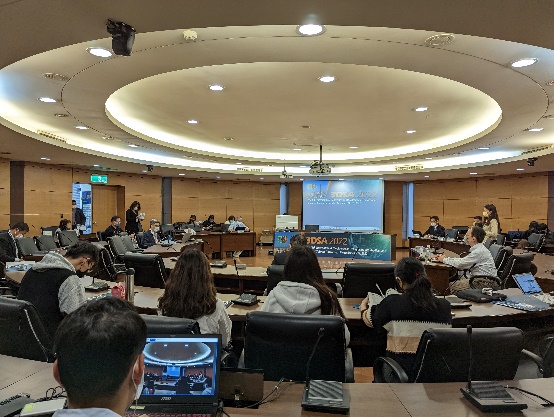 |
|
3DSA 2022 conference venue, Barry Lam Hall, National Taiwan University |
This year, the 13th International Conference on 3D Systems and Applications, 3DSA 2022 has appointed Prof. Hoang-Yan Lin of GIPO National Taiwan University (also Supervisory Board Chairman of 3DIDA and Director of the Ministry of Education Advanced Display Technology and Cross-Professional Talents Recruitment and Training Program) as the chief organizer, a joint organization effort between three research and administrative parties. Due to the ongoing Covid-19 pandemic at the time of organization, the 3DSA 2022 was organized as a hybrid interactive extended reality international conference, enlisting help from Osense to provide the metaverse platform. The result is a wonderful hybrid metaverse conference ranging over two days (24-25th Nov), a vast improvement from the previous account of the meterverse conference (IDW 2022, Fukuoka, Japan).
|
 |
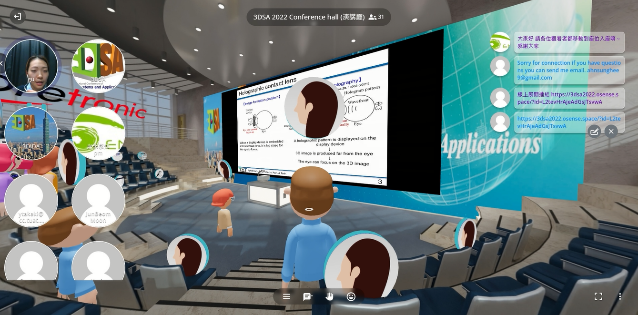 |
|
3DSA 2022 innovative metaversal conference |
3DSA 2022 reported on the most current research and advanced display technology and its cross-field applications both within Taiwan and around the globe. A total of five invited special topics, 48 research presentations, and 20 thesis posters, including the most recent advanced display technology SRB research results funded by the Ministry of Science and Ministry of Economics. Over the course of the two day conference, the participants count reached a total of 130 members from different fields and professions, bringing a satisfactory and successful closing to 3DSA 2022.
|
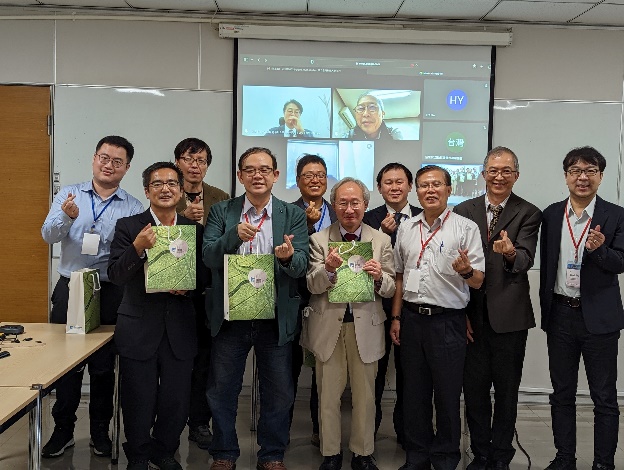 |
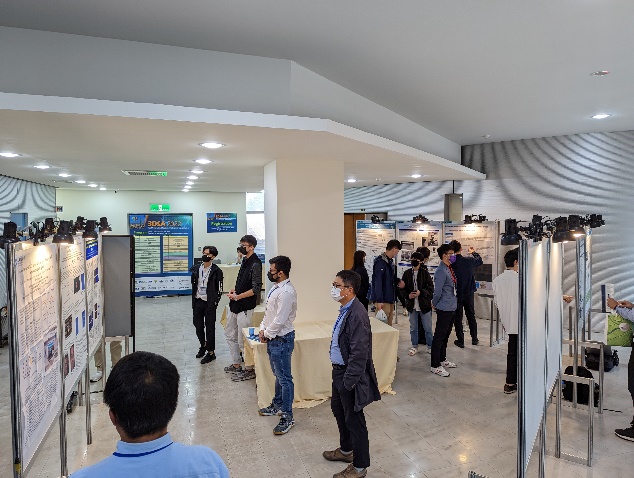 |
|
3DSA 2022 Conference. Left: 3DSA representatives meeting. Right: Poster schedule |
At the closing ceremony, the conference chair presented the Best Thesis Award and the Best Poster Award. Afterwards, the 3DSA flag was passed over to Japan representative Prof. Shiro Suyama of Tokushima University (Tokushima, Japan). Jointly, the Taiwan 3DSA representatives and Korea 3DSA representatives and Japan 3DSA representatives celebrated the success of 3DSA 2022, and we look forward to the next 3DSA 2023 at Niigata, Japan.
|
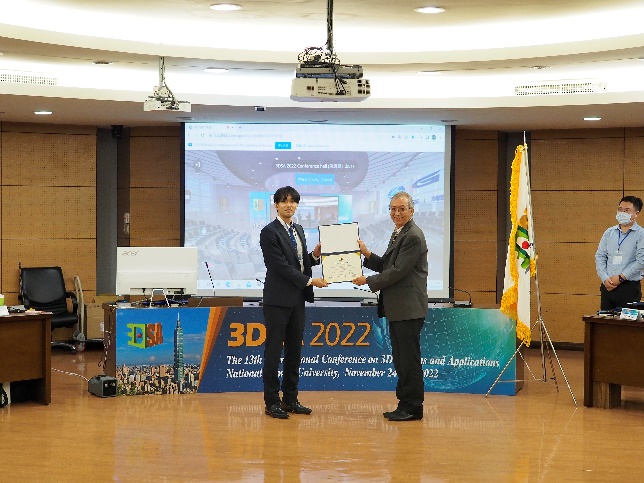 |
 |
|
3DSA closing ceremony, presenting the Best Thesis Award and the Best Poster Award |
|
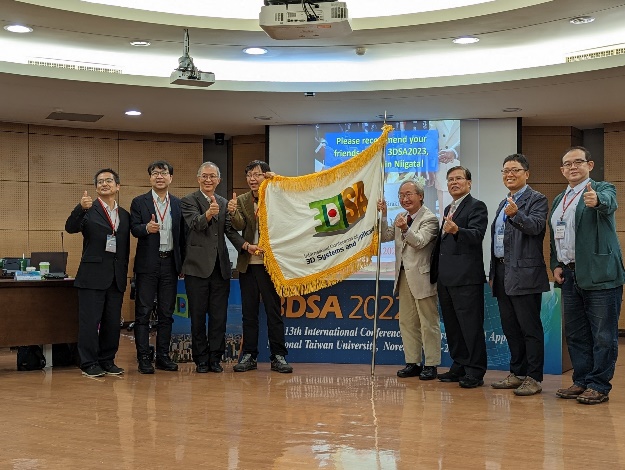 |
 |
|
3DSA flag passing ceremony |
Conference representatives at the banquet |
|
|
|
|

|
|

|
|
| |
|
|

|
|
Enhanced Color Conversion of Colloidal Quantum Dots Located in the Hot Spot of the Surface Plasmon Coupling between InGaN/GaN Quantum Wells and Surface Ag Nanoparticles
Professor C. C. (Chih-Chung)
Yang
Graduate Institute of Photonics and Optoelectronics, National Taiwan University
For improving the performance of the photon color conversion from the energy of an InGaN/GaN quantum-well (QW) structure into the longer-wavelength emission of a colloidal quantum dot (QD), we insert the photoresist (PR) solution of the QD into a surface nano-hole, whose bottom face is about 10 nm higher than the top QW. The sample top surface is then cleaned for depositing Ag nanoparticles (NPs) to induce the surface plasmon (SP) coupling between the QW structure and surface Ag NPs such that the QDs inside the nano-holes are located in the region of strong electromagnetic field distribution (hot spot). In this situation, the SP coupling can enhance the Förster resonance energy transfer (FRET) from QW into QD and the QD emission efficiency for producing a stronger color conversion process. The nanoscale-cavity effect of the nano-hole structure can further strengthen the SP-coupling enhanced FRET and QD emission. Green-emitting QD (GQD) and red-emitting QD (RQD) are used for preparing three samples, including samples GQD, RQD, and GQD+RQD. Figures 1(a)-1(d) show the structure of the samples under study. Figure 2 shows the localized surface plasmon resonance behaviors in the three samples. Figure 3 shows the continuous photoluminescence (PL) spectra of the three samples demonstrating the results of color conversion enhancement.
|

|
|
Fig. 1. (a): Schematic illustration of the sample structure, which includes a surface nano-hole array located between a QW structure and surface Ag NPs and filled with the PR solution of QD. (b): Cross-sectional TEM image of the QW template showing the thickness of the capping layer at ~50.8 nm. (c) and (d): Plane-view and cross-sectional SEM images of the fabricated nano-hole array, respectively. The nano-hole depth is ~40.3 nm.
|
|

|
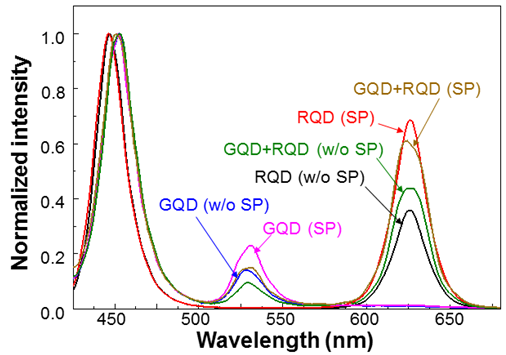
|
|
Fig. 2. Transmission spectra of the three samples after surface Ag NP deposition. The vertical dashed lines indicate the emission wavelengths of the QW, GQD, and RQD. The insert shows the SEM image of sample GQD after Ag NP deposition.
|
Fig. 3. Normalized continuous PL spectra of the three samples in the cases with and without SP coupling.
|
Molecular Beam Epitaxy Growth of GaAsBi on (001) GaAs
Professor Hao-Hsiung Lin's Lab
Graduate Institute of Photonics and Optoelectronics, National Taiwan University
Doping a tiny amount of Bi in GaAs can effectively reduce the energy gap without deteriorating the crystallinity. We have used molecular beam epitaxy to grow GaAsBi epi-layer on GaAs at 300~340°C. The surface morphology shows that excess Ga flux results in Ga/Bi mixed droplets, while excess Bi flux causes Bi droplets. Only a narrow growth widow is left for a good epitaxial surface. The RSMs for (004), (115), and (224) planes all show a 450-nm-thick GaAs0.96Bi0.06 epilayer is coherently grown on the GaAs substrate. TEM lattice image shows a Λ shape area near the GaAsBi/GaAs interface. We can see that dumbbells, representing pairs of GaAs or GaBi atoms, are distorted in the area. Bi atoms could gather together along close-packed plane and form the Λ shape area, where their bonds are coherently strained. Temperature dependent photoluminescence of GaAsBi samples is shown in Fig. 4. The peaks locate in 1.1~1.2 eV showing a S-shaped behavior resulting from the localized Bi states. Albeit the luminescence bands are broad, the peak shift is very limited. These findings indicate that GaAsBi is a potential material for multi-junction solar cells and temperature insensitive light emitting devices.
|
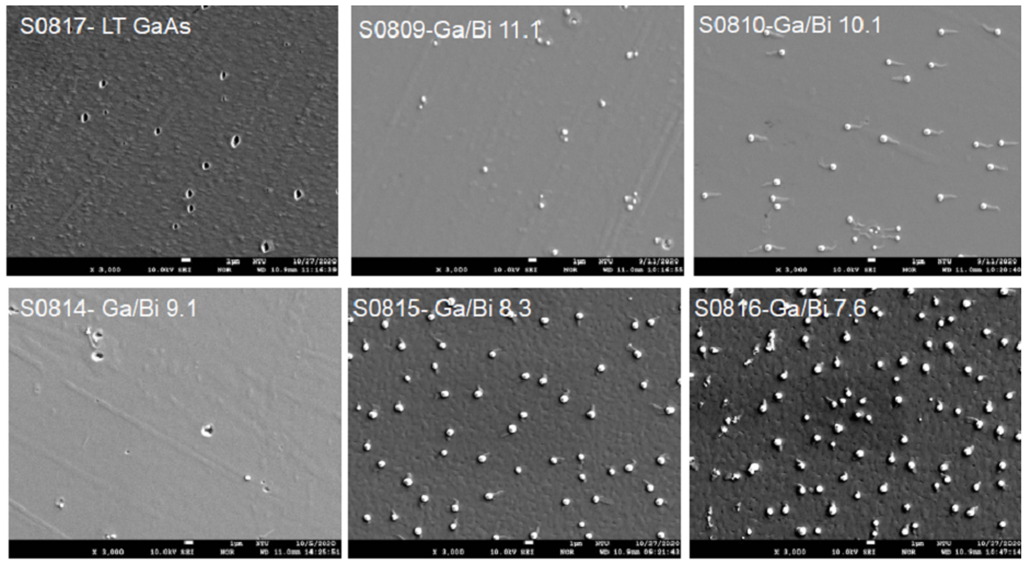
|
|
Fig. 1. Surface morphologies of GaAs and GaAsBi grown with different Ga/Bi flux ratios. Higher ratios give Ga/Bi droplets, lower ratios give Bi droplets. The growth widow is very narrow.
|
|

|
|
Fig. 2. Reciprocal space mapping (RSM) of (004), (115), (224) planes show the coherent growth of GaAsBi on GaAs.
|
|
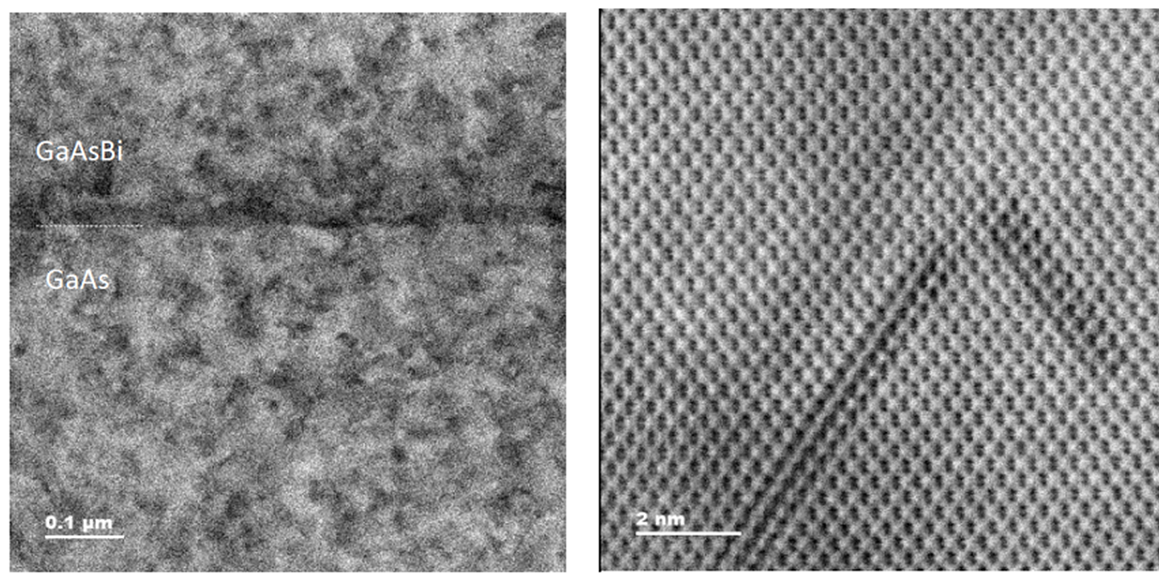
|
|
Fig. 3. Bright field TEM image in left panel shows a dark GaAsBi/GaAs interface. The lattice image in the right panel shows a Λ region in which the dumbbells are distorted.
|
|

|
|
Fig. 4. S-shaped temperature dependent Photoluminescence of GaAsBi samples grown with different growth conditions.
|
High-Performance Full-Color Micro-LED Display Using Fluorescent Color Conversion Layer Technology
Professor Ching-Fuh Lin
Graduate Institute of Photonics and Optoelectronics, National Taiwan University
Micro-light-emitting diodes (micro-LEDs) with remarkable advantages are becoming the mainstream technology for next-generation display applications. However, further developments and commercialization of micro-LEDs still face significant difficulties. For example, the mass transfer is limited in the speed and the production yield.
To address this issue, our group explores the high-performance color-conversion layer to replace the mass transfer technique for full-color micro-LED displays. The quantum yields of our color-converted films are 89% for red color and 85.1% for green color with the blue light excitation. Furthermore, we develop an extremely cost-effective, and highly-stable technique to fabricate these color-conversion films and micron-size subpixel arrays on them. This process allows us to significantly control each pixel’s position, size, spacing, and thickness. In particular, for the fully efficient use of incident light to enhance the color saturation and light output efficiency, the fluorescent arrays are made on color-purity-enhancement film with a recycling-reflection mechanism, replacing the traditional glass substrate approach. Our fluorescent arrays have subpixels with a dimension of 7 x 7 microns. The pixel density reaches 3176 PPI for single-color arrays and 1588 PPI for full-color arrays on the glass substrate and the color-purity-enhancement film, respectively, as illustrated in figure 1. With the color-purity-enhancement film implementation, the color gamut extension attains a high value of 97.4% of the DCI-P3 extent, as shown in figure 2. Smaller pixel sizes, less than 5 um x 5um, are in development and show promising progress. Our work creates a new pathway for the future development of micro-LED displays.
|
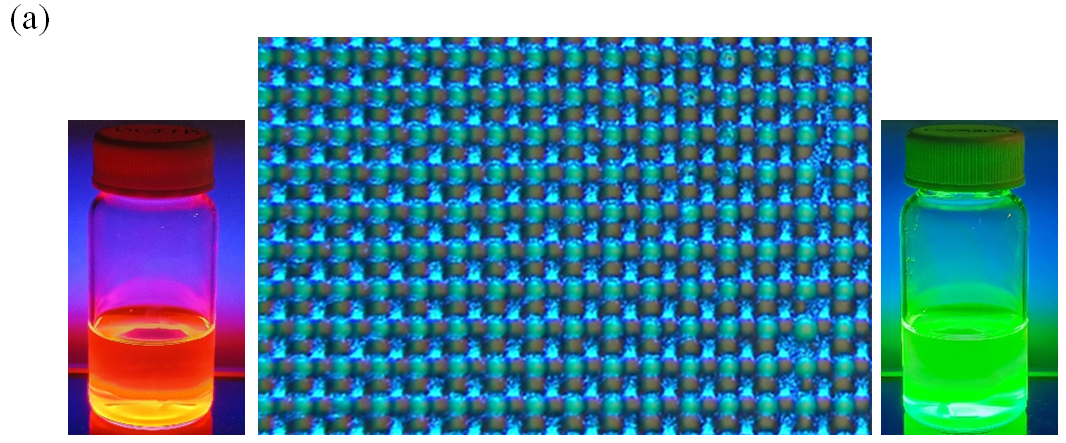
|
|
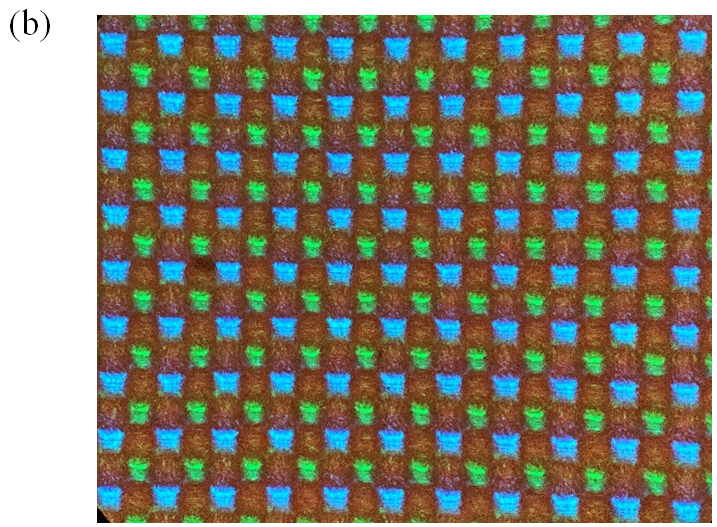
|
|
Fig. 1. (a) Red and green fluorescent solutions and fluorescent arrays on the glass substrate, (b) Fluorescent arrays on the color-purity-enhancement film under blue light, respectively.
|
|
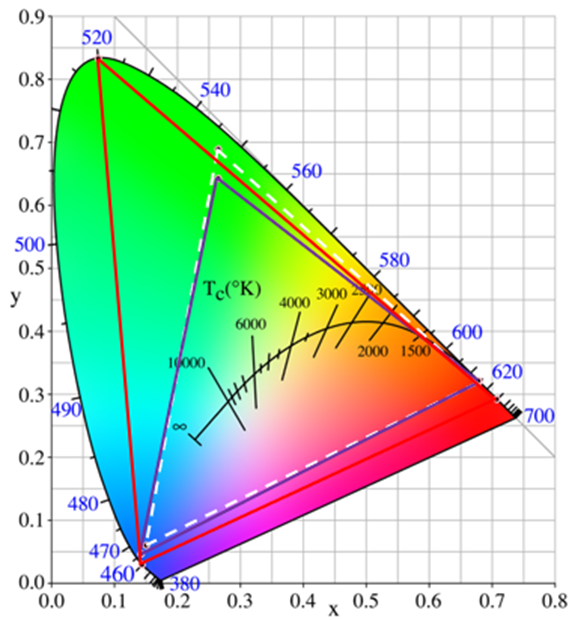
|
|
Fig. 2. The color spaces of fluorescent arrays in the CIE 1931 chromaticity diagram with purple, red, and white areas for fluorescent arrays on the glass substrate, the color-purity-enhancement film, and the DCI-P3 standard, respectively.
|
Photoluminescence Measurement of Ge/Ge0.95Si0.05 and Ge/Ge0.9Sn0.1 Epilayers
Professor Chee-Wee Liu
Graduate Institute of Photonics and Optoelectronics, National Taiwan University
The photoluminescence (PL) measurement provides a non-destructive method to investigate the epilayer quality after CVD epitaxial growth. The strong PL spectra indicates low defect density in the epilayers, which is required for better device performance. In this work, two different designs of epilayers were grown by CVD epitaxy and measured by PL to characterize the epilayer quality. 8 Ge0.95Si0.05 channels sandwiched by Ge sacrificial layers (SLs) (Fig.1 (a)) with the strong PL spectra of Ge0.95Si0.05/Ge (Fig.1 (b)) is demonstrated. Moreover, the PL spectra of 8 Ge0.9Sn0.1 channels sandwiched by Ge SLs and Ge0.97Sn0.03/Ge double caps (Fig.2 (a)) shows two peaks (Fig.2 (b)), which refers to the Ge0.9Sn0.1 and the Ge0.97Sn0.03/Ge.
|
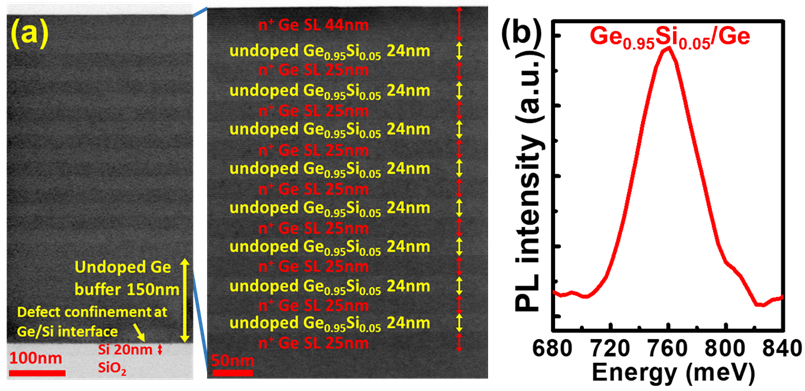
|
|
Fig. 1. (a) TEM images and (b) PL spectra of 8 Ge0.95Si0.05 channels sandwiched by Ge SLs [1].
|
|

|
|
Fig. 2. (a) TEM images and (b) PL spectra of 8 Ge0.9Sn0.1 with Ge SLs and Ge0.97Sn0.03/Ge double caps [2].
|
Reference:
[1] Y.-C. Liu et al., IEEE Symposia on VLSI Technology and Circuits (VLSI), T15-2, 2021
[2] C.-E. Tsai et al., IEEE International Electron Devices Meeting (IEDM), pp. 569-572, 2021
|
|
|
|

|
|

|
|
|
|
 |
|
 |
|
|
|
|